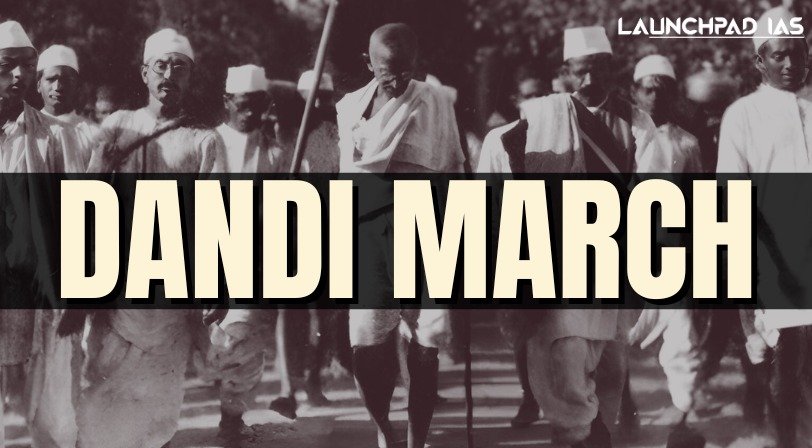- The Dandi March, also known as the Salt March and the Dandi Satyagraha, was an act of nonviolent civil disobedience led by Mohandas Karamchand Gandhi.
- The march lasted from 12th March 1930 to 6th April 1930 as a direct action campaign of tax resistance and nonviolent protest against the British salt monopoly.
- On 12th March, Gandhiji set out from Sabarmati with 78 followers on a 241-mile march to the coastal town of Dandi on the Arabian Sea. There, Gandhi and his supporters were to defy British policy by making salt from seawater.
- At Dandi, thousands more followed his lead, and in the coastal cities of Bombay and Karachi, Indian nationalists led crowds of citizens in making salt.
- Civil disobedience broke out all across India, soon involving millions of Indians, and British authorities arrested more than 60,000 people. Gandhiji himself was arrested on 5th May, but the satyagraha continued without him.
- On 21st May, the poet Sarojini Naidu led 2,500 marchers on the Dharasana Salt Works, some 150 miles north of Bombay. The incident, recorded by American journalist Webb Miller, prompted an international outcry against British policy in India.
- In January 1931, Gandhiji was released from prison. He later met with Lord Irwin, the viceroy of India, and agreed to call off the satyagraha in exchange for an equal negotiating role at a London conference on India’s future.
- In August 1931, Gandhiji traveled to the conference as the sole representative of the nationalist Indian National Congress. The meeting was a disappointment, but British leaders had acknowledged him as a force they could not suppress or ignore.
Background
- The Lahore Congress of 1929 authorized the Congress Working Committee (CWC) to launch a program of civil disobedience, including non-payment of taxes.
- On 26th January 1930, “Independence Day” was observed, with the national flag being hoisted in different venues and patriotic songs being sung.
- In February 1930, a CWC meeting at Sabarmati Ashram invested Gandhiji with full powers to launch the Civil Disobedience Movement at a time and place of his choice.
- Gandhiji’s ultimatum to Lord Irwin, the Viceroy of India (1926-31), stated that the minimum demands had been ignored and that there was only one way out of civil disobedience.
Effect of the Movement
- Civil Disobedience in different forms continued in different provinces. Special stress was laid on the boycott of foreign goods.
- In eastern India, payment of the chowkidari tax was refused. This no-tax campaign became very popular in Bihar.
- In Bengal, J.N. Sengupta defied Government laws by reading openly the books banned by the government.
- Defiance of forest laws assumed a mass character in Maharashtra.
- The movement had taken a firehold in the provinces of U.P., Orissa. Tamil Nadu, Andhra Pradesh and Assam.
Significance of Dandi March
- Imports from Britain had fallen considerably. For example, imports of cloth from Britain had fallen by half.
- The movement was more widespread than the previous one. Mass participation including women, peasants, workers, students, urban elements like merchants, shopkeepers provided the Congress a new all-India status.
- The support that the movement had garnered from the poor and the illiterate both in the town and countryside was remarkable.
- For Indian women, the movement was the most liberating experience to date and can genuinely be said to have marked their entry into the public space.
- Although the Congress withdrew the Civil Disobedience in 1934, the movement received global attention and marked a critically important stage in the progress of the anti-imperialist struggle.
Gandhi’s Previous Experiments with Civil Disobedience
- Transvaal Protest in South Africa:
- Gandhi opposed the Transvaal immigration act in South Africa.
- 1906: Legislation in Transvaal required the Indians to register themselves and carry registration certificates at all times.
- Gandhi initiated passive resistance or “satyagraha” and called the Indians to burn their certificates in public.
- Later, the authorities even imposed restrictions on the interprovincial movement of Indians and declared their Hindu marriages legally invalid.
- Finally, in 1913, Gandhi launched a March from Natal to Transvaal, crossing the border illegally.
- These Marchers were sent to jail and treated brutally. But the struggle paid off, and under the Gen.Smut-Gandhi agreement, most of their demands were accepted.
- Champaran Satyagrah:
- It was Gandhi’s first CDM in India
- Indigo farmers were relieved by less tax at the end.


